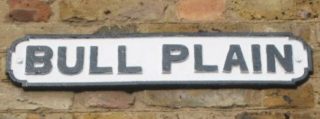
Street sign (credit: Caroline Churton)
Bull Plain, an attractive and unusually wide street in the centre of Hertford, is the former site of the town’s cattle market and is named after The Bull Inn, which used to be located on the west side at No. 15. Connecting Maidenhead Street and Salisbury Square with Folly Island, the street contains several fine 17th- and 18th-century buildings, although like other areas of Hertford it has seen its fair share of changes over the years since 1911.
The 1911 census, Kelly’s Directory of Hertfordshire (1910 and 1912 editions) and Bennett’s Business Directory (1911-12 edition) reveal that at the time the street included a mixture of businesses offering a wide variety of services, and several privately occupied residences. The even-numbered properties are located on the east side of the street and the odd-numbered ones on the west side.
No. 1, on the corner of Maidenhead Street, was the home of Joseph J. Rayment, the owner of a well-established building, decorating and plumbing company (the commercial premises were accessed from No. 2 Maidenhead Street). A single man, aged 29 and from Hertford, he lived there with his brother Albert, 25, who was also a builder, and their sister Ethel, 26. A housekeeper, Helen Jones, 64, from Guernsey in the Channel Islands, was also resident in the spacious 10-room house.
Opposite at No. 2, at what was known as Rose’s Corner (more recently Oddbins), was Rose & Sons, a printing works and stationers run by John Rose.
At No. 3 was the White House Dairy, the proprietors of which were listed as Say & Linsell. Edmund Coulson Say, 25, a dairyman from Wood Green in Middlesex, lived on the premises with his wife of two years, Eva Jane, also 25, from Upper Clapton in Middlesex, and their 6-month-old son Charles. The Linsell referred to could possibly be Frank Richard Linsell, a 21-year-old from Hackney in London, who was living at that time with his aunt in Ware Road, Hertford, and was listed in the 1911 census as a ‘dairyman’. The business had been established for nearly a century and advertised ‘Pure rich milk delivered twice daily direct from the farm. Special cows kept for nursery milk.’ Another dairyman, Arthur Mills, was also listed at No. 3 Bull Plain in the local business directories of the time, although no specific details about him are given. The 1911 census includes three people with this name and, interestingly, all of them are dairymen – but none of them is described as living in (or near) Hertfordshire so it is difficult to identify which one may have been working at the White House Dairy during this period.
The 1910 and 1912 editions of Kelly’s Directory of Hertfordshire and Bennett’s Business Directory (1911-12 edition) all refer to Samuel Gee at No. 4 as a shopkeeper or, more specifically, a confectioner, but in both the 1901 and 1911 censuses he is described as a house painter, which is rather puzzling! Samuel, 39, from Bishop’s Stortford, Hertfordshire, had married Annie Maria, 38, from Brandon in Suffolk, in 1901 and they had three children – Stanley Samuel, 7, Edith Annie, 5, and May, who was less than 1 month old. Sadly a fourth child had died. Also living at this address were Jane Fordham, 47, from Tewin, Hertfordshire, described as a ‘monthly nurse’, and a boarder named Arthur Whiting, 19, from Southminster in Essex, who was a grocer’s assistant.
According to the 1911 census there was an uninhabited shop at No. 5. However, the 1912 edition of Kelly’s Directory of Hertfordshire lists one Ernest Ward, confectioner, at this address, although no further information is available.
Thomas Edward Ellis, 32, originally from Rochdale in Lancashire, was a hairdresser, working from his home at No. 6. He had been married to Mary, 32, a local Hertford girl, for eight years and their only child to date had died.
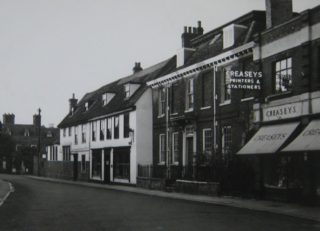
Bull Plain, probably slightly later than 1911 but showing Creasey’s still at Nos. 7 and 9 on the right (credit: Hertfordshire Archives & Local Studies)
Listed at Nos. 7 and 9 was the firm of George Creasey & Sons, printers, retail stationers, copperplate engravers and die stampers. George, 54, was married to Harriet, 55, both from Hertford, and they had four children. The youngest three, Horace George, 26, also a printer, May, 20, and Dorothy, 19, still lived at home in 1911, but by then the eldest, Herbert, 33, also a printer, had married and moved to No. 16 St John’s Street, Hertford. His wife of six years was Daisy, 24, and they had two sons and a daughter – George Edward, 5, Herbert Leslie, 4, and Ethel May, 2.
No. 8 was a private house of six rooms, occupied by Frederick James B. Rowley, 69, a farm implement agent and dealer, originally from Luton in Bedfordshire, and his wife of 14 years, Mary, 73, from Watton at Stone, Hertfordshire. They had one domestic servant, Annie Palnoster, 18, from Stevenage, who lived in.
Nos. 10 and 12 were private houses which appear to have been uninhabited at the time of the census in 1911 – no further details are available.
There was a cycle shop at No. 11, run by James Stevens, 42, a cycle/motor engineer and dealer originally from Caterham in Surrey. Bennett’s Business Directory (1911-12 edition) describes him as a ‘cycle maker and repairer’ and states that he was an ‘Agent for Triumph cycles and Edison Phonographs’. James’s wife of 22 years was Emily Jane, 42, from Hertford and three of their four children were living with them in 1911, all of whom had been born in Caterham. Dora Gertrude, 16, assisted in the family business, as did her brother Rodney St Vincent, 14, described as a cycle mechanic. The youngest daughter, Vera Margrett, 5, was at school. The eldest daughter, Gwendoline May, 19, had left home by this time and was working as a mental nurse/attendant in the Metropolitan District Imbeciles Asylum at Leavesden.
Herbert Morris Reynolds, 41, was a boot maker and repairer, with a shop at No. 13. A Hertford man, he had been married to Clara, 37, from Riseley in Bedfordshire, for three years and they had a baby daughter, Nora Kathleen, aged just 9 months.
The census records a warehouse at No. 14, but provides no further details regarding its use.
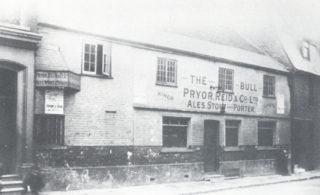
The Bull Inn, before 1914 (credit: Hertfordshire Archives & Local Studies)
No. 15 was one of the most significant buildings in the street because it was here that The Bull Inn, which gave Bull Plain its name, was situated. The resident publican and proprietor was John Dumbrell, 66, from Swan Lane in the City of London, who lived there with Sarah, 66, his wife of 41 years, from Lambeth in London. They had no children, but their niece, Sarah Parker, 41, also from London, lived with them, though she appeared not to be involved in the running of the inn (or to have any other occupation). The census records her as married, but there’s no mention of her husband. Two boarders, both single men, also lived on the premises – James Wright, 42, from Hertford, who was described as a woodman on an estate, and Arthur Buttery, 24, a boot repairer from Atterby in Lincolnshire. On the night of the 1911 census a visitor was recorded – he was Arthur Sands, 34, from Hurst Green in Sussex. He was a boot maker so perhaps he was there to see Arthur Buttery, being in the same business?
The inn is described in Bennett’s Business Directory (1911-12 edition) as selling ‘Ales, wines and spirits of the best quality’. By 1903 the inn was owned by the Rayments Brewery of Furneux Pelham, but it was subsequently sold to the Pryor Reid Brewery, which was based in Hatfield. It finally closed in 1917.
The original timber-framed and plastered building with its old tiled roof (which today comprises Nos. 13a, 15 and 15a) is Grade II listed and dates back to the 16th and 17th centuries. It was extensively remodelled as a public house in the late 19th century and further alterations were made in the 20th century. No. 13a is currently occupied by InDepth Diving Services.
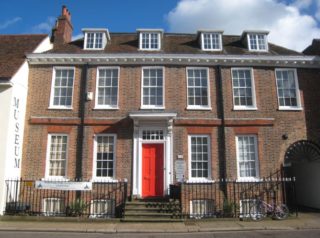
Beadle House, originally built c. 1702-4, as it is today (credit: Caroline Churton)
In 1911 No. 16 was listed as a warehouse and it was probably a rather shabby place. However, the original building, built in c.1702-04, had started life as the home of the Dimsdales, a local family of repute, several members of which were doctors, and accordingly it was known as Dimsdale House. About 35 years after the 1911 census was taken the building was transformed once again, having been saved from redevelopment and newly listed Grade II*, and the elegant Queen Anne building that we see today became known as Beadle House.
No. 17 was a private residence, occupied by Matilda Glazebrook, 58, a widow from Bayford near Hertford, and her 13-year-old grand-daughter, Bertha Elizabeth Hale, who had been born in Hertford. Matilda’s husband, Henry, a licensed victualler, had died in 1904 at the age of 50. At the time of the 1901 census Bertha was already living with them (then at No. 5 Honey Lane, Hertford), but there are no details of her parents in either the 1901 or the 1911 census.
The house in Bull Plain had six rooms and in 1911 there were also four boarders living there – Sydney Pullen, a married man of 40, originally from Somerset, who was a bricklayer; Alfred Cole, 25, from Cirencester in Gloucestershire, who was a carpenter; Arthur John Spicer, 42, from Benington, Hertfordshire, who was a miller’s labourer; and Augustus John Smith, 20, a flour miller from Saxmundham in Suffolk. The building, which now houses the offices of Protego Mortgage Planning, is Grade II listed.
One of the best-known buildings in the street is Tooke House, currently comprising both Nos. 18 and 20. In 1911 No. 18 was occupied by Thomas Matthias Pamphilon, 61, a plumber by trade and a Hertford man. He lived there with his wife of 19 years, Agnes Elizabeth, 45, who originally came from Islington in London, and their four children, all of whom had been born in Hertford. The eldest, Harry, 27, was also a plumber. No occupation is given for the eldest daughter, Dorothy, 17, but her younger sister, Sarah, 15, was a dressmaker’s apprentice. The younger son, Henry, 16, was a printer’s apprentice. Their home was large, with 11 rooms.
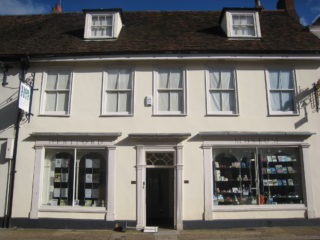
No. 18 Bull Plain, part of Tooke House in 1911 but now a separate building housing Hertford Museum (credit: Caroline Churton)
A couple of years after the census, in 1913, the Pamphilon family sold the building, known at that time as Walton House, for £800 to Robert Thornton Andrews and William Frampton Andrews, who were the founding brothers of Hertford Museum. Their family had lived in Hertford since the 17th century. The Andrews had opened the original museum in October 1903 at their offices at No. 56 Fore Street (now Nos. 98-100), but in 1914 they moved to the building in Bull Plain that still houses the museum to this day.
The timber-framed building, now Grade II listed, dates to around 1610, although it has an 18th-century exterior. It was built by William and Mary Tooke, who also built and owned No. 20, hence the name Tooke House.
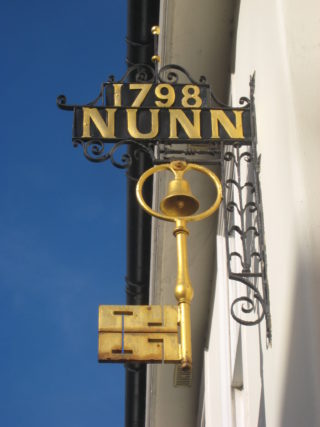
The key sign on the Hertford Museum building (credit: Caroline Churton)
The distinctive Nunn key sign, dated 1798, which hangs on the wall of the museum, came from a Hertford ironmonger known as Nunn’s, whose premises were located at No. 18 Fore Street. This family-run business, established in 1798 and trading until 1901, sold a wide variety of items ranging from iron hurdles, wire netting, glass, cutlery, lamps and tools to general ironmongery. They had workshops at the back where they made and repaired guns and cartridges, and they also carried out bell-hanging. It is thought that the key sign was hung outside the museum building as an advertisement for the business – it is certainly an attractive artefact.
No. 19, now a Grade II listed building, was another private residence, housing a large family of 10 people in six rooms. Robert Johnson, 46, from Hertford, was a gasfitter’s labourer. He lived there with his wife of 17 years, Emily, 46, from Cheshunt, Hertfordshire, their seven surviving children – tragically no fewer than five others had already died – and his 90-year-old widowed mother, Mary, from Brickendon, Hertfordshire. The two oldest children, Robert, 16, and Emily, 14, had both been born in Brickendon; the remaining children had all been born in Hertford. They were Mary, 13, Alfred, 12, Violet, 5, William, 2, and the baby of the family, Henry, who was just three months old.
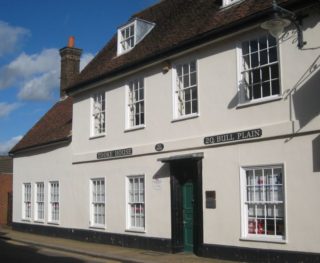
No. 20 Bull Plain (Tooke House) as it is today (credit: Caroline Churton)
No. 20, the other part of the building known as Tooke House, was described in the 1911 census as a ‘mission house’. It was occupied by a single 39-year-old lady called Alice Warner, a parish worker from Woodford in Essex, and Clara Wrenn, 26, a general domestic servant from Pottersheath, Hertfordshire. They had plenty of living space as the building had nine rooms!
No. 21 was a private six-room residence (now Grade II listed) occupied by the Taylors. The head of the family was John Taylor, 39, a maltster’s labourer from Ware, Hertfordshire, who had been married to Elizabeth, 24, from Sawbridgeworth, Hertfordshire, for six years. Five children were listed in the 1911 census – Rosetta, 16, John, 6, Frederick, 5, Doris, 3, and Herbert, 1. Rosetta was John’s daughter from a previous marriage (his first wife had died).
There appear to be no census records for Nos. 22 and 24. No. 23 was the site of an uninhabited warehouse.
No. 25 was another private residence (with six rooms), the home of the Edwards family. The head of the household was Edward, 48, a domestic gardener from Buntingford, Hertfordshire, who was married to Elizabeth, 47, from Hertford. Their son Arthur, 16, a boot maker’s assistant, was still living with them when the census was taken, but their 19-year-old daughter, Annie, had moved away from home. She might have been the same Annie Edwards who was working as a domestic servant at the George Inn in Watton-at-Stone at this time.
No. 27 was another family home, occupied by Herbert George Thomason, 31, a carman (delivery man) for a flour miller, originally from Arlesey in Bedfordshire, his wife of five years Eliza Ann, also 31, from Bengeo, Hertford, and several other relatives. They had two young children, Herbert William Rodolph, 3, and Bessie Maud, 1. Also living with them was Martha Clarke, 56, who was Herbert’s mother-in-law and a widow, from More [?] Green, Hertfordshire, as well as three of his brothers-in-law and his sister-in-law, all from Bengeo, Hertford. William Edward Clarke, 26, was a carman for a furniture remover; Joseph Cushi Clarke, 24, was a general labourer; and Alfred George Clarke, 15, worked as a skin dresser in a leather mill – perhaps he was employed by William Webb & Co., Ltd, at Horn’s Mill in Bullock Lane, Hertford? Gertrude Lily Clarke, 17, spent her days at home.
No. 29 was also a private residence, the home of Joshua Allum, a widower aged 58, from Brickenden, Hertfordshire, who worked as a woodman on a private estate to support his large family. His wife, Catherine, had died in 1907 at the age of 49. His eldest son, Henry, 21, was no longer living at home at the time of the 1911 census, but his other son, Joseph, 20, worked with him, also as a woodman. The rest of the household comprised six daughters – Mary, 24, Florrie, 18, Alice, 16, Dorothy, 14, Bertha, 10, and Winiefred [sic], 6. It must have been rather crowded in the house as there were only three rooms!
There are no records in the census or local directories for Nos. 30-34, the next reference being to No. 35, which was divided into four separate private dwellings. No. 35a had two rooms and was inhabited by Thomas Wilson, 69, a hawker (firewood seller) from Shoreditch in London, and his much younger wife of 12 years, Eliza, 30, a Hertford girl. They had no children. At No. 35b, also a two-room home and now Grade II listed, lived Thomas Dray, 65, a labourer at a sewage works, from Hertford, and his wife of 37 years, Ellen, 67, who came from Hitchin, Hertfordshire. They had had eight children, but only one was still alive in 1911, although no longer living with them at home. No. 35c, similarly with two rooms and now Grade II listed, was the home of Marther [sic] Clark, 69, a widow, from Hertford. She had taken in a boarder, Eliza Jennings, 73, also a widow, from Waterford near Hertford, who was described as a charwoman, presumably working for Mrs Clark. No. 35d, a slightly larger home with three rooms, was occupied by a 74-year-old widow, Elizabeth Shadbolt, who was a nurse and midwife working for the Borough Council. She was originally from Devon.
The Game family lived at No. 37, a three-room house. James, 27, a bricklayer’s labourer from Hertford, had been married to Emily, 26, also from Hertford, for six years and they had three children – Wilfred, 5, Charles, 4, and Catherine, 2. A fourth child had died, aged just 1 year old.
No. 39 was the home of Joseph Burgess, 20, from Hertford, who worked as a porter in the drapery business. He lived there with his mother, Elizabeth, a 60-year-old widow, who was a charwoman.
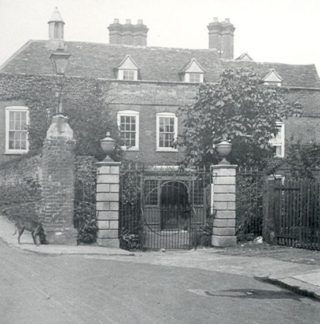
Lombard House, late 19th/early 20th century (credit: Hertfordshire Archives & Local Studies)
Finally, the large and imposing building (unnumbered) in a dominating position at the head of Bull Plain, near the little bridge leading to Folly Island, housed the Hertford Conservative & Liberal Unionist Club. At the time of the 1911 census the President was the Marquess of Salisbury, CB, the Honorary Secretary was H. Clinton-Baker, the Assistant Secretary was William R. Sutherland, and the House Steward was Henry Thomas Adams. The latter, aged 54 and originally from Hampton Wick in Middlesex, lived on the premises with his wife and children. He had been married to Ann, 56, from Chalk in Kent, for 28 years and they had three daughters – Ethel, 27, a dressmaker, Daisy, 26, and Dorothy, 23, also a dressmaker. Two other children had sadly died.
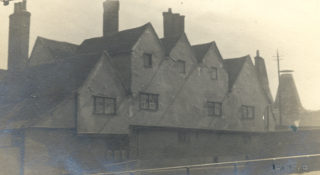
The rear of Lombard House, c. 1910, revealing its medieval origins, which are still evident today (credit: Hertfordshire Archives & Local Studies)
Known as Lombard House, this historic timber-framed and plastered building dates from c. 1442 and takes its name from an occupant of that time. The medieval origins of this 15th-century hall house are still evident at the back of the building, which overlooks the River Lea near Folly Bridge – the five gables, the overhanging upper storey and the wood-mullioned windows remain in their original condition.
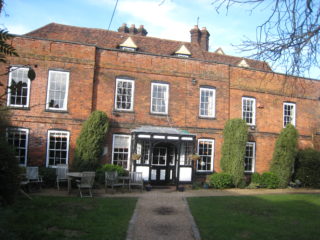
Lombard House, now The Hertford Club, as it is today (credit: Caroline Churton)
The building was extended in the early 17th century and the fine brick frontage that is seen today was rebuilt in the mid-18th century. More recent renovations were made in the 1980s after a fire. The gateway is now Grade II listed and Lombard House itself is Grade II* listed.
In the 1680s it was the home of Sir Henry Chauncy (1632-1719), historian, JP and barrister. He was also Steward of the Borough and subsequently Recorder of Hertford under the Charter of 1681, county historian and author of The Historical Antiquities of Hertfordshire (1700). The property was also known as Malloryes (after Robert Mallory) and during the 18th century was used as a judges’ residence (presumably during the Assizes).
Just four years after the census was taken this area of Bull Plain was the scene of a tragic event. On the night of 13 October 1915 there was a Zeppelin L16 raid over Hertford. Four prominent townsmen who had come out of Lombard House to see what was happening were killed by the third high-explosive bomb, which fell onto Bull Plain outside the entrance gate to the Conservative Club at exactly 10 p.m. The Club and several other buildings nearby, notably Nos. 25, 27 and 29, were badly damaged. The Zeppelin had apparently mistaken the River Lea for the River Thames and believed it was bombing the East End of London.


Add your comment about this page
In 1901 my Grand Mother Lived at 24 Bull Plain, she was aged 13, her father was a Clerk Steward, so I can only assume it was a residence then before as you comment it became converted and then a disused warehouse.
How very interesting to read about Bull Plain from entries in the 1911 Census. My Great Grandfather Joshua Allum and his family lived at No. 29 and my Grandfather and Grandmother Mr and Mrs James Game at No. 37. Obviously the connection is not noted here my grandmother was Mr Allum’s daughter. It seems very strange to be able to see how my family lived over 100 years ago. It is also very sad to make the connection that this was the area bombed by a zeppelin in 1915 at the height of WW1, when my Uncle George Stephen Game a child of 3 was killed. Thank you for all this archive information.